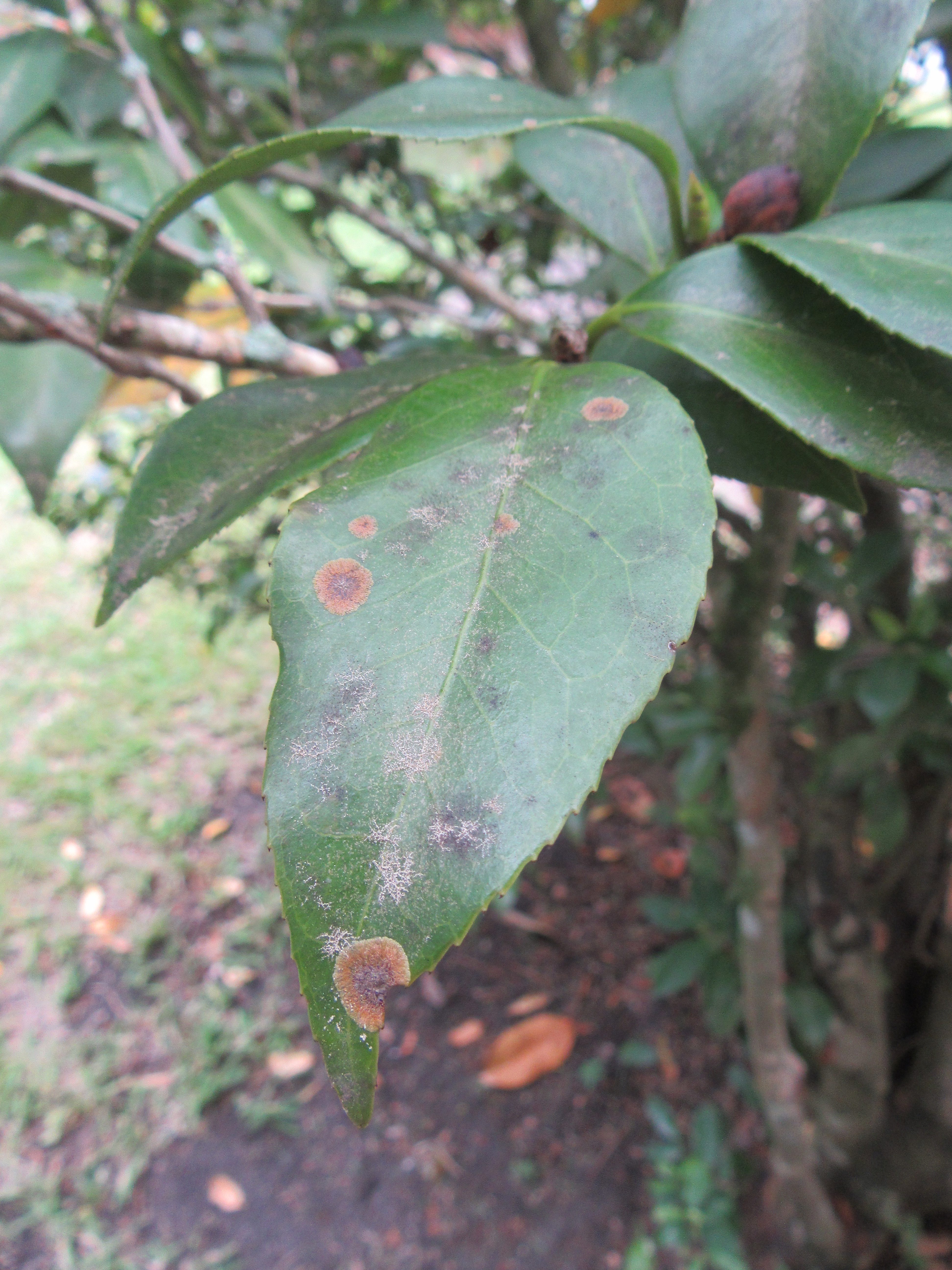
by Matt Lollar | Jun 29, 2017
Algal leaf spot, also known as green scurf, is commonly found on thick-leaved, evergreen trees and shrubs such as magnolias and camellias. It is in the genus Cephaleuros and happens to be one of the only plant parasitic algae found in the United States. Although commonly found on magnolias and camellias, algal leaf spot has a host range of more than 200 species including Indian hawthorn, holly, and even guava in tropical climates. Algal leaf spot thrives in hot and humid conditions, so it can be found in the Florida Panhandle nearly year round and will be very prevalent after all the rain we’ve had lately.
Symptoms
Algal leaf spot is usually found on plant leaves, but it can also affect stems, branches, and fruit. The leaf spots are generally circular in shape with wavy or feathered edges and are raised from the leaf surface. The color of the spots ranges from light green to gray to brown. In the summer, the spots will become more pronounced and reddish, spore-producing structures will develop. In severe cases, leaves will yellow and drop from the plant.
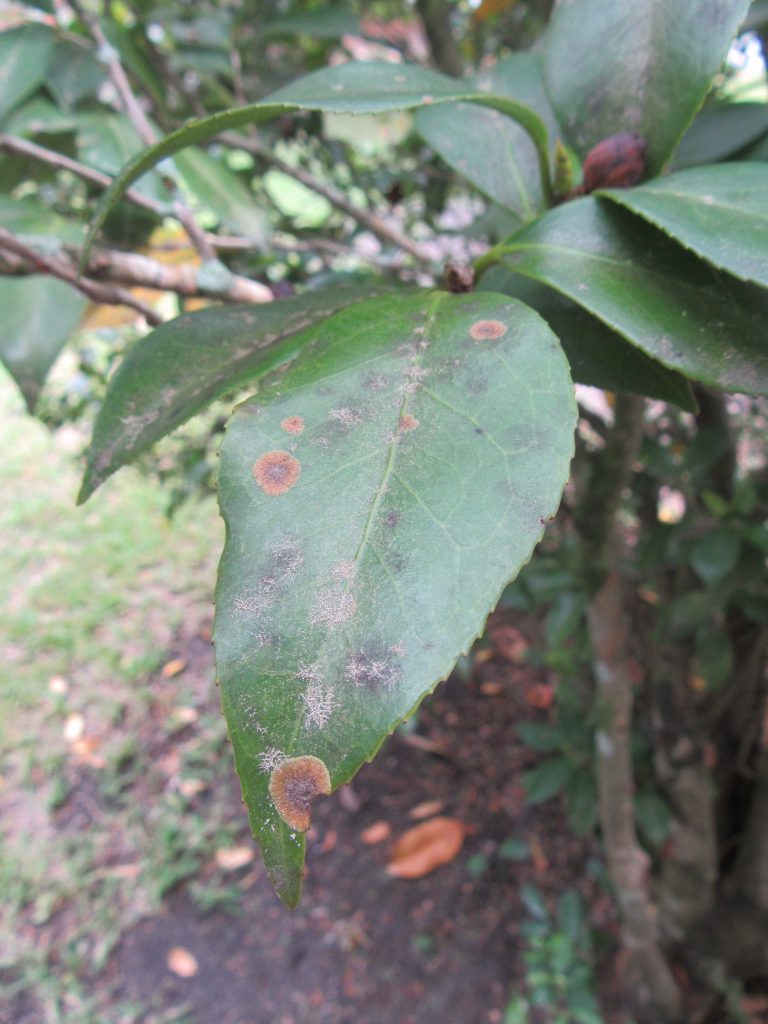
Algal leaf spot on a camellia leaf. Photo Credit: University of Florida/IFAS Extension
The algae can move to the stems and branches in more extreme cases. The algae can infect the stems and branches by entering through a small crack or crevice in the bark. The bark in that area cracks as a canker forms that eventually can girdle the branch, killing it.
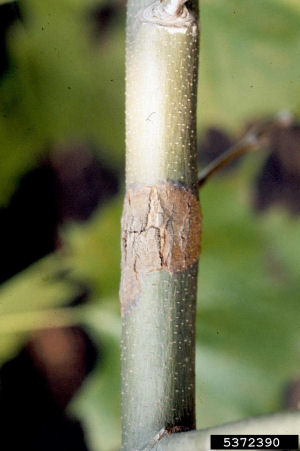
Algal leaf spot on a sycamore branch. (Platanus occidentalis). Photo Credit: Florida Division of Plant Industry Archive, Bugwood.org.
Management
In most cases, algal leaf spot is only an aesthetic issue. If only a few leaves are affected, then they can just be removed by hand. \It is important that symptomatic leaves are discarded or composted offsite instead of being left in the mulched area around the trees or shrubs. If symptomatic leaves are left in the same general area then irrigation or rain water can splash the algal spores on healthy leaves and branches. Infected branches can also be removed and pruned.
Preventative measures are recommended for long-term management of algal leaf spot. Growing conditions can be improved by making sure that plants receive the recommended amount of sunlight, water, and fertilizer. Additionally, air circulation around affected plants can be increased by selectively pruning some branches and removing or thinning out nearby shrubs and trees. It is also important to avoid overhead irrigation whenever possible.
Fungicide application may be necessary in severe cases. Copper fungicides such as Southern Ag Liquid Copper Fungicide, Monterey Liqui-Cop Fungicide Concentrate, and Bonide Liquid Copper Fungicide are recommended. Copper may need to be sprayed every 2 weeks if wet conditions persist.
Algal leaf spot isn’t a major pathogen of shrubs and trees, but it can cause significant damage if left untreated. The first step to management is accurate identification of the problem. If you have any uncertainty, feel free to contact your local Extension Office and ask for the Master Gardener Help Desk or your County Horticulture Agent.
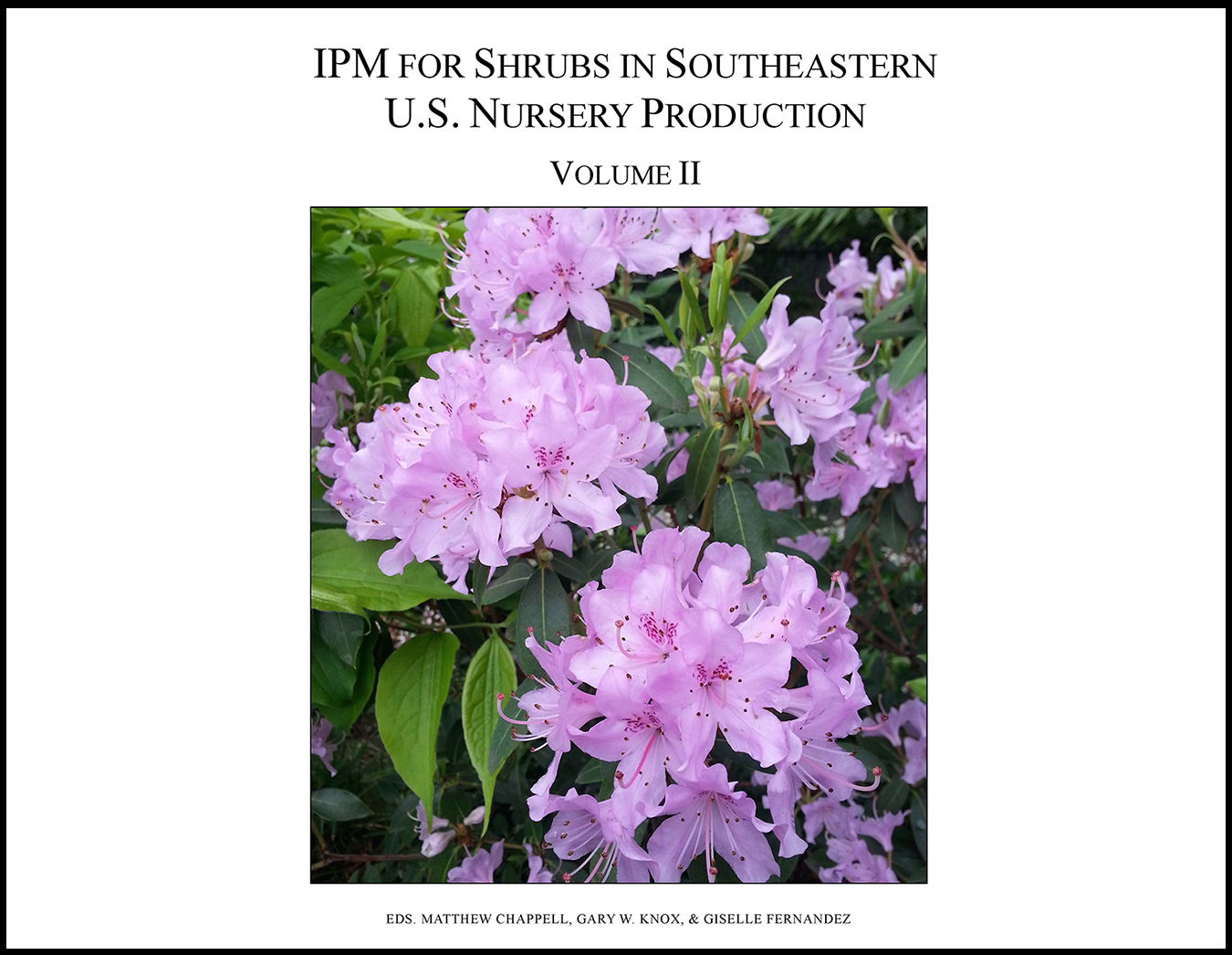
by Gary Knox | Jun 29, 2017

IPM for Shrubs in Southeastern US Nursery Production Volume II is the third book released by the Southern Nursery Integrated Pest Management Working Group (SNIPM) and includes chapters on hydrangea, loropetalum, holly, rhododendron (including azalea), Indian hawthorn, and weed management. Each chapter covers history, culture and management of the major species and cultivars in production, as well as arthropod pest management and disease management. Within the discussion of these topics, each chapter includes strategies for developing effective IPM programs for key pests and plant pathogens, including tables of fungicides and insecticides for use with these key organisms. While developed for nursery producers, this information also may be useful to landscapers, students, arborists and others.
This free book is downloadable as pdf chapters at
http://wiki.bugwood.org/IPM_Shrub_Book_II.
The first book, IPM of Select Deciduous Trees in Southeastern U.S. Nursery Production, was released in May 2012 and is available for free download as chapter .pdf files at http://wiki.bugwood.org/SNIPM and as an eBook from the iTunes Bookstore https://itunes.apple.com/us/book/ipm-for-select-deciduous-trees/id541182125?mt=11.
The second book, IPM for Shrubs in Southeastern US Nursery Production Volume I, was released in June 2014 and can also be downloaded as chapter .pdf files at http://wiki.bugwood.org/SNIPM or from the iTunes Bookstore at https://itunes.apple.com/us/book/ipm-for-shrubs-in-southeastern/id903114207?mt=11.
The SNIPM Working Group is a multi-disciplinary group of Extension professionals formed to more efficiently and effectively develop and deliver educational programming to the southern U.S. nursery and landscape industry.
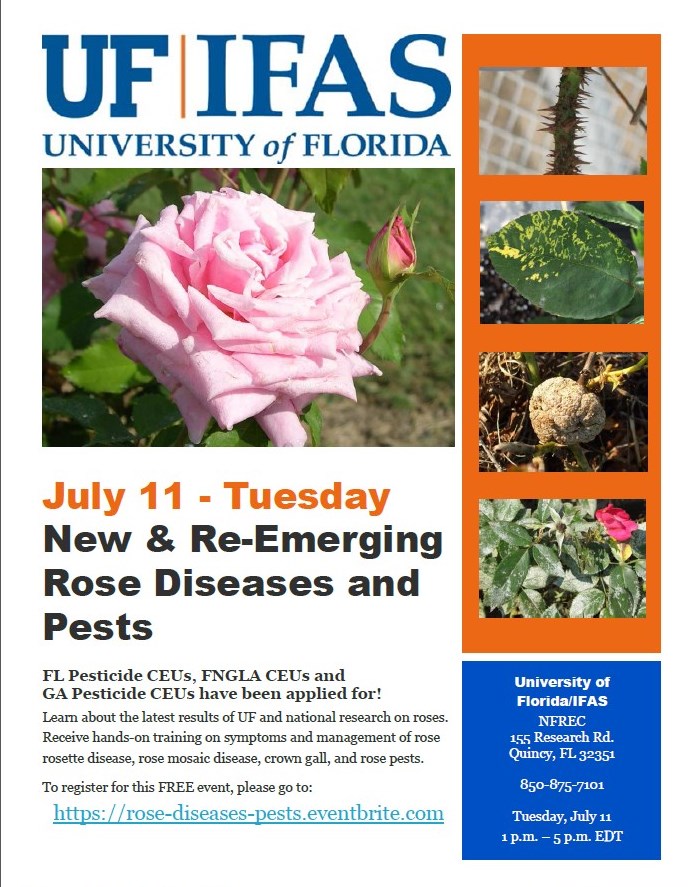
by Gary Knox | Jun 22, 2017
Come to this free workshop to learn about the latest results of University of Florida and national research on roses. Receive hands-on training on symptoms and management of rose rosette disease, rose mosaic disease, crown gall, and rose pests.
FL Pesticide CEUs, FNGLA CEUs and GA Pesticide CEUs have been applied for!
This program is geared for nursery and greenhouse growers, landscapers, municipal maintenance personnel, Extension personnel, Rosarians, rose enthusiasts and science teachers. Sponsored by Farm Credit of Northwest Florida and Harrell’s.
To register for this FREE event, please go to: https://rose-diseases-pests.eventbrite.com


by Blake Thaxton | May 18, 2017
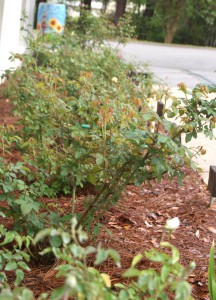
Properely pruned plants will produce vigroous new growth and ample new flowers. Even though these roses were pruned in February, soon it will be time to prune azaleas, right after they finish their bloom.
Pruning is something all homeowners and landscapers know is one of the many chores to be completed in the landscape. Everyone recognizes that pruning needs to be done on occasion, but it can be confusing to know how to prune the variety of species that can be in a landscape. There are some simplistic principles that can be followed while pruning.
Reasons for pruning:
- Training – to form good structure or good branching.
- Maintain plant vigor
- Control plant form and size
- Influence plant flowering and fruit
When to prune?
Several factors need to be considered when deciding the proper time to prune. If the plant species has a showy bloom to then consider the time of year it blooms. Some landscape plants flower on last years growths, therefore must be pruned following bloom time just before the flower buds are set for next year (ex. azaleas, spireas, and dogwoods). Plants grown with little regard to blooms, such as foliage plants like hollies, can be pruned from January to late Summer.
Learn More:
the following are great extension publications on pruning. read these to learnt he finer details of pruning so you can become an expert. Always remember to call your local extension office if you have any questions regarding pruning.
UF/IFAS – Pruning Landscape Shrubs and Trees
Alabama Cooperative Extension – Pruning Ornamental Plants
UF/IFAS Pruning website
by Daniel J. Leonard | Apr 24, 2017
Almost every landscape has a problem area where the sun just doesn’t shine and many plants won’t make it, maybe it’s the north side of your house, under a small tree, or tucked away in an oddly-shaped alcove. We all know the same old boring green choices that work well here (Holly Fern, Cast Iron Plant, etc.) but maybe you want something a little bit different, something that will provide a pop of color and interesting texture! Look no further than a recent introduction, a whole-plant mutation discovered from the little-used Grape Holly (Mahonia spp.), aptly named ‘Soft Caress’.
‘Soft Caress’ Mahonia is a beautiful little evergreen shrub from the Southern Living Plant Collection (one of the best of the collection in my opinion) and really is a game changer for full-shade areas. Some of you may remember the traditional Mahonia, also known as Grape Holly, from your grandmother’s lawn. Those plants were coarse, spiny, produced messy purplish berries and often appeared generally unkempt. ‘Soft Caress’ is a major departure from its parent. Possessing finely-cut, deep green, bamboo-like foliage, this plant’s texture really contrasts well with many traditional shady species. As a bonus, ‘Soft Caress’ sends up brilliant yellow-gold flower spikes in the dead of winter, certainly a welcome respite from the other barren plants in the landscape; although in this unusually warm year, the plants are just now blooming in the Panhandle.

Photo courtesy: Daniel J. Leonard
‘Soft Caress’ is advertised to grow three feet in height and width, a more manageable size than the larger traditional Mahonia species, but I’m not sure I’d take that as gospel, the three-year old plants (hardly mature specimens) in my parent’s landscape are already that size and show no signs of slowing down. However, I’ve found you can easily manage their size with a once a year prune to slow down some of the more rapidly-growing canes. Be sure to time the prune as soon as possible after flowering is finished as ‘Soft Caress’ blooms only once a year and produces its flowers on the previous season’s wood, just like Indica Azaleas and old-fashioned Hydrangeas.
The uses in the landscape for ‘Soft Caress’ Mahonia are nearly endless. It pairs well with almost anything in a shady mixed shrub border. It works nicely as a foundation plant against a porch or under windows on the north or east side of a house where it will be protected from hot afternoon sun; I have employed a grouping of the plants in this way in my own lawn with success. It even thrives in containers! If you want to show off some serious horticultural design skills, mix ‘Soft Caress’ in a large container on the porch with some like-minded perennials for a low-maintenance, high-impact display that you don’t have to replant each season. All this shrub requires is partial to full shade, moist well-drained soil, and an occasional haircut to keep it looking tidy! If you’ve been struggling to find a plant that’s a little more unusual than the standard garden center fare and actually looks good in shady spots, you could do a lot worse than ‘Soft Caress’ Mahonia. 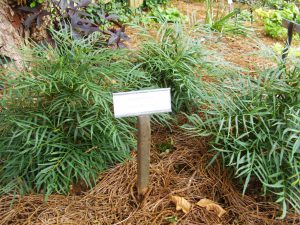
As always, happy gardening and contact your local UF/IFAS County Extension office for more information about this plant and other gardening questions!
by Julie McConnell | Apr 7, 2017
It’s really tempting to buy a tree and plant it in the middle of your lawn or directly in front of your picture window, but instead take some time to choose the best spot first. Several considerations such as maintenance and mature size should be taken into account before the site is selected.
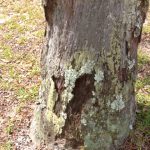
Mowing close to the trunk of this Pindo palm has caused repeated injury to the trunk. Photo: JMcConnell, UF/IFAS
Placing a tree in a lawn area without creating a bed can lead to maintenance issues for both the tree and the turfgrass. It is easy to simply cut out a small patch of turf the size of the rootball and install a tree, however, as the grass grows up towards the trunk over time maintaining that grass will become difficult. It is common to see mechanical injuries to tree trunks because weed eaters or mowers have chipped away at the bark when trying to cut the grass. Other potential problems are irrigation zones calibrated for turf delivering the wrong amount of water to trees and herbicides used on grass that may cause injury to trees.
Over time, as the tree canopy grows, it will create shade and any grass trying to grow in that area will thin and be more susceptible to disease and insect pressure. By creating a large ornamental bed for your tree, you will prevent some pitfalls associated with placing the tree in the lawn.
Another common mistake is planting a tree too close to a house or other structure. It can be difficult to imagine how large a tree will grow at maturity because it is not a quick process. Trees placed close to houses may grow into eaves and shed leaves onto roofs and into gutters. This adds to maintenance and can provide mosquito breeding grounds. Also, some tree roots may interfere with walkways or septic systems and should be sited far enough away to avoid these issues.
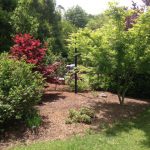
These Japanese Maples are planted in a bed separate from the lawn making care for both plant types easier. Photo: JMcConnell, UF/IFAS
Be sure to research any tree you plan to install to find out ideal growing conditions and mature size. If you plan ahead and use good maintenance practices, a tree can become an valuable part of your home landscape to be enjoyed for years to come.











